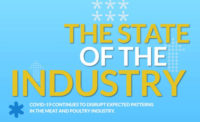STATE OF THE INDUSTRY: ANIMAL AGRICULTURE
State of the Industry: The year of H5N1, or the year that animal agriculture unites across species?
NIAA looks to build on its work to unite industry leaders for the advancement of animal agriculture.

Calf pasturing in rangeland at the USDA-ARS Livestock and Range Research Laboratory in Miles City, MT. (Photo by Tom Geary, D4904-1).
In the animal agriculture world, 2024 may be known as the year of H5N1. Traditionally known as Highly Pathogenic Avian Influenza (HPAI), the virus is a contagious disease of birds posing a major threat to the poultry industry. The H5N1 strain of this disease is devastatingly deadly and can wipe out entire flocks of poultry in a matter of days. 1
H5N1 is not new to the animal kingdom. The first H5N1 outbreak was identified in the U.S. as early as the 1920s.2 By the 1980s, the virus had experienced multiple evolutions and was seen in domestic and wild birds and was implicated to impact human health.3 Fast forward to 2022 and H5N1 was detected in various non-agriculture mammals. In March 2024, the first case of H5N1 is detected in infant goats on a farm where the backyard flock had also tested positive. Days later, H5N1 was reported in cows in Kansas and Texas dairies. By April, the first cow-to-human transmission was reported in the U.S.4
H5N1 has a mortality rate of nearly 100 percent in poultry flocks, and often leads to millions of birds culled to contain the outbreak, resulting in massive economic impacts. In 2015, the U.S. suffered $3 billion in economic losses.5
In April 2024, The National Institute for Animal Agriculture (NIAA) was preparing for Annual Conference – an annual convening of animal agriculture professionals. The concern of the zoonotic disease grew more quickly than the virus due to its unknown impacts and scale. NIAA added a roundtable discussion that consisted of a consulting dairy veterinarian in Texas, the state veterinarian from Kansas, and a veterinarian from the Centers for Disease Control and Prevention. With representation from multiple species and sectors of the animal agriculture value chain in attendance, the roundtable discussed the new infections, how they were being researched and what information had been learned to date.
In the early days of the outbreak, little was known about transmission to humans through an infected cow’s milk. Researchers and species associations were quick with responses to the public health concerns to ensure safety. The fear that the virus would or could spread into beef cattle or swine is still very real today. Swine production has some of the most rigorous biosecurity measures among animal agriculture, but there is still risk.
One takeaway from the roundtable discussion at Annual Conference was that experts had been working in proverbial silos and were now struggling to address the zoonotic disease across the barnyard and in human health. The state veterinarian may not know who to contact in the state health department to collaborate and share information. Some dairy experts did not know who to contact in the poultry sector to learn from past experiences. Since animal movement quickly became a concern, connecting animal and human health professionals across state lines became a priority.
After Annual Conference, NIAA leaders identified an opportunity to ensure various individuals and organizations could leverage each other’s insights and expertise. NIAA was asked to convene a virtual “meet and greet” to ensure animal agriculture was holistically addressing H5N1 – a task that can be nearly impossible if species and health officials don’t know how to reach across the industry for information or assistance. NIAA connected leaders from more than 40 national associations and governmental agencies in the animal agriculture sector. These new collaborations led to shared insights and protocols to address biosecurity, worker health and safety, food safety, animal care, and more.
In July, The National Pork Board (NPB) partnered with NIAA to convene a group of public health, animal health and swine professionals to build relationships, provide an open forum for dialogue, and explore opportunities for One Health6 collaborations.
At the end of August, NIAA hosted a reversal of the previous farm tour experience with a meeting in Atlanta at the CDC campus with animal agriculture leaders across species sectors. This meeting supported CDC delegates at the World AMR Congress and the UN General Assembly discussion on antimicrobial resistance as they provide informed One Health testimony including perspectives and practical applications from experts and professionals in the animal agriculture sector.
When animal agriculture is faced with a new disease affecting animal health or issue facing the animal agriculture industry, NIAA works to connect leaders for broader consensus and information. NIAA was founded in 1916 to address the problems and opportunities of controlling and eradicating livestock diseases and improving livestock handling procedures. In more than 100 years, NIAA has seen dozens of diseases affecting animal agriculture and has celebrated the eradication of several. The mission today is to convene animal agriculture experts and allies in collaborative settings to explore, discuss, learn, and develop knowledge that fosters interdisciplinary cooperation for the improvement and continuous progress of animal agriculture. While 2024 may be remembered as the H5N1 year in animal agriculture, NIAA will remember it as a year we were able to coalesce leaders for the advancement of animal agriculture.
Morgan J. Young is director of communications and outreach with National Institute for Animal Agriculture.
- Avian Influenza, Animal and Plant Health Inspection Service, U.S. Department of Agriculture, 30 Aug. 2024, www.aphis.usda.gov/livestock-poultry-disease/avian/avian-influenza.
- “1880-1959 Highlights in the History of Avian Influenza (Bird Flu) Timeline.” Avian Influenza (Bird Flu), The Centers for Disease Control and Prevention, 30 Apr. 2024, https://www.cdc.gov/bird-flu/avian-timeline/1880-1959.html#:~:text=1924,markets%20in%20New%20York%20City.
- “1960-1999 Highlights in the History of Avian Influenza (Bird Flu) Timeline.” Avian Influenza (Bird Flu), The Centers for Disease Control and Prevention, 30 Apr. 2024, www.cdc.gov/bird-flu/avian-timeline/1960-1999.html.
- “2020-2024 Highlights in the History of Avian Influenza (Bird Flu) Timeline.” Avian Influenza (Bird Flu), The Centers for Disease Control and Prevention, 30 Apr. 2024, www.cdc.gov/bird-flu/avian-timeline/2020s.html.
- Avian Influenza in Wild Birds and Poultry: Dissemination Pathways, Monitoring Methods, and Virus Ecology. Blagodatski et al. https://www.ncbi.nlm.nih.gov/pmc/articles/PMC8161317/
- “What Is One Health.” One Health, World Health Organization, 21 Sept. 2017, www.who.int/news-room/questions-and-answers/item/one-health.
Looking for a reprint of this article?
From high-res PDFs to custom plaques, order your copy today!





